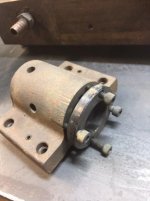I just bought a Bridgeport J head, 2HP variable speed, made in 1980.
The table and saddle are off and Im cleaning the nuts. Two questions...
I understand that there are two versions of these nuts. The original is cut part way through and is expected to bend to adjust backlash. The new version is two nuts that slide along the keyway to adjust the back lash. I have the former. I do not know if these nuts are original, aftermarket or made by a previous owner but they seem wrong.
1) The crossfeed nut has its slot cut 90 degrees away from where I would expect it. The adjustment screw doesn't apply force in the middle of the cut to 'bend' the nut. It applied the force at the edge of the cut. This has to be defective as it cannot work. Am I missing something?
2) The longitudinal feed nut isn't long enough. The adjustment screw head goes all the way into the hole before it contacts the nut and therefore the small screw that should keep it from rotating... does nothing. Also the adjustment screw never contacts the nut because it is stopped by a ledge. Again, what am I missing? None of this seems right.
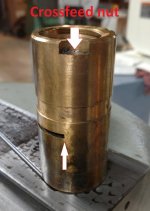
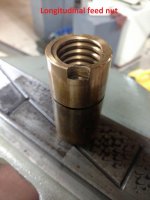
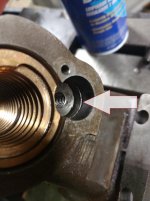
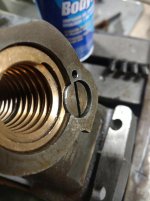
The table and saddle are off and Im cleaning the nuts. Two questions...
I understand that there are two versions of these nuts. The original is cut part way through and is expected to bend to adjust backlash. The new version is two nuts that slide along the keyway to adjust the back lash. I have the former. I do not know if these nuts are original, aftermarket or made by a previous owner but they seem wrong.
1) The crossfeed nut has its slot cut 90 degrees away from where I would expect it. The adjustment screw doesn't apply force in the middle of the cut to 'bend' the nut. It applied the force at the edge of the cut. This has to be defective as it cannot work. Am I missing something?
2) The longitudinal feed nut isn't long enough. The adjustment screw head goes all the way into the hole before it contacts the nut and therefore the small screw that should keep it from rotating... does nothing. Also the adjustment screw never contacts the nut because it is stopped by a ledge. Again, what am I missing? None of this seems right.




Last edited:



